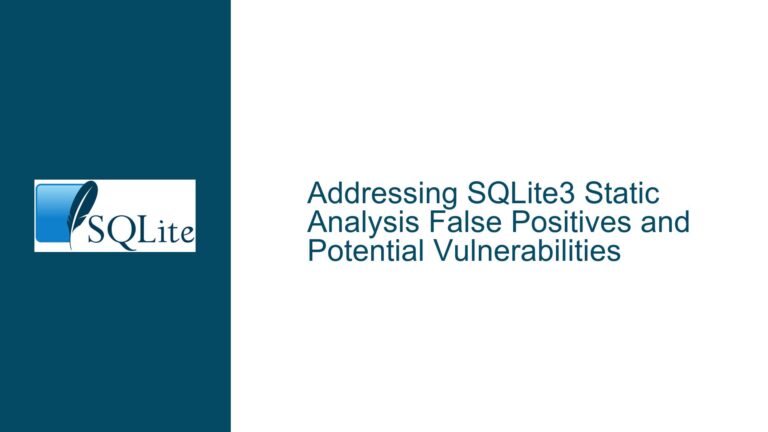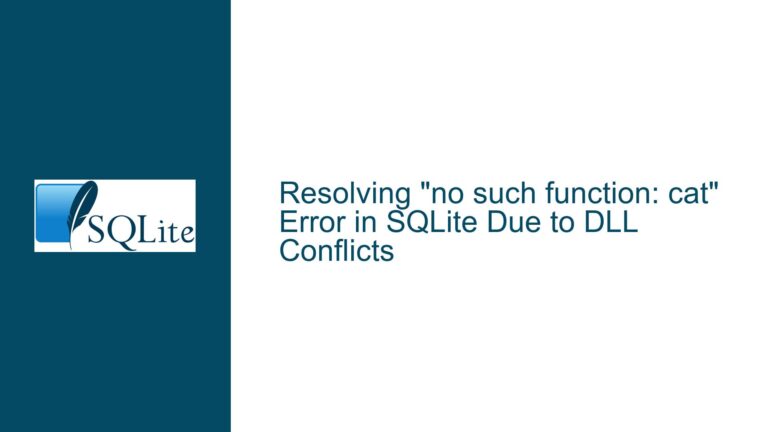Implementing Client-Side Encryption for SQLite WASM in Browser Environments
Issue Overview: Challenges in Integrating Async Encryption with SQLite WASM VFS
The core challenge revolves around attempting to implement client-side encryption for SQLite databases in browser environments using the WebAssembly (WASM) build. Developers want to encrypt/decrypt the entire database file transparently during read/write operations via an asynchronous middleware layer. This requires intercepting file system operations at the Virtual File System (VFS) level used by SQLite’s WASM implementation. The primary technical constraints stem from the incompatibility between JavaScript’s asynchronous encryption APIs and SQLite’s synchronous C-language API, along with the granularity of data access in SQLite’s VFS architecture.
The SQLite WASM build uses the Origin Private File System (OPFS) via specialized VFS implementations (sqlite3-opfs-async-proxy.js and sqlite3-vfs-opfs.js) to enable persistent storage in browsers. These components manage low-level block I/O operations, not whole-file transactions. Encryption at this layer would require modifying how individual database pages (blocks) are encrypted/decrypted during read/write operations. However, the asynchronous nature of JavaScript cryptography APIs (Web Crypto, libsodium.js) conflicts with SQLite’s expectation of synchronous I/O at the VFS level. Additionally, security concerns arise regarding key management: any encryption key used client-side must be embedded in JavaScript or provided by users, creating exposure risks.
Possible Causes: Architectural Constraints and Security Tradeoffs
Three fundamental factors prevent straightforward implementation of async encryption middleware for SQLite WASM:
Synchronous vs. Asynchronous API Mismatch
SQLite’s C API expects synchronous I/O operations, while browser-based encryption APIs are predominantly asynchronous. The WASM build bridges this gap via OPFS asynchronous I/O, but layering additional async encryption atop this would require resolving Promises in a synchronous call stack. Emscripten’s Asyncify tool can simulate synchronous behavior for async code, but this adds complexity and performance overhead. The existingsqlite3-opfs-async-proxy.jsVFS already uses async OPFS handles, but modifying it to include encryption would require reengineering its data flow to await cryptographic transformations before completing read/write operations.VFS Block-Level I/O Granularity
SQLite’s VFS operates on fixed-size blocks (default: 4096 bytes), not entire database files. Encrypting the entire file as a single blob is incompatible with this model. Each block must be encrypted/decrypted individually, requiring a block cipher mode (e.g., CBC, CTR) that preserves block alignment. This complicates key management and initialization vector (IV) handling, as each block may need unique IVs to prevent cryptographic vulnerabilities. Modifying the VFS to support per-block encryption would require interceptingxReadandxWritemethods to apply transformations, but coordinating this with asynchronous crypto operations would destabilize the VFS’s locking and transaction mechanisms.Client-Side Key Exposure Risks
Even if async encryption were technically feasible, storing or deriving encryption keys in browser memory exposes them to extraction via DevTools, memory inspection, or XSS attacks. User-provided passphrases (via PIN/password prompts) can mitigate this by deriving keys dynamically, but the derived key must reside in JavaScript memory during database operations, creating a window of vulnerability. Furthermore, browser extensions or malicious scripts could intercept keystrokes or modify encryption routines.
Troubleshooting Steps, Solutions & Fixes: Strategies for Secure Client-Side Encryption
Approach 1: Custom VFS with Synchronous Crypto Operations
Step 1: Implement a Synchronous Crypto Layer
Use a WebAssembly-compiled cryptographic library (e.g., libsodium-WASM) that exposes synchronous functions. This avoids async/Promise conflicts with SQLite’s C API. Modify the OPFS VFS (sqlite3-vfs-opfs.js) to invoke these synchronous crypto functions during block I/O:
// Pseudo-code for modified xWrite method
const blockCipherEncrypt = (block, key) => {
// Synchronous encryption using WASM crypto
return encryptedBlock;
};
const xWrite = (fileId, buffer, offset) => {
const block = buffer.slice(offset, offset + blockSize);
const encryptedBlock = blockCipherEncrypt(block, encryptionKey);
return opfsHandle.write(encryptedBlock, { at: offset });
};
Step 2: Handle Initialization Vectors (IVs)
Store IVs per-block in a reserved section of the database file or a separate OPFS file. During writes, generate a new IV for each block and prepend/appended it to the encrypted data. During reads, extract the IV before decryption.
Step 3: Key Management
Derive encryption keys from user-provided passphrases using PBKDF2 or Argon2 implemented in WASM. Never store the derived key; regenerate it on each session using the passphrase kept in memory only during active use.
Limitations:
- Synchronous crypto in WASM may block the main thread, degrading UI responsiveness.
- IV management increases storage overhead and complexity.
- Browser extensions can still intercept keystrokes during passphrase entry.
Approach 2: Asyncify-Powered Async VFS Modifications
Step 1: Enable Emscripten’s Asyncify
Recompile the SQLite WASM build with Asyncify support to allow async/await in C API callbacks. This enables the VFS to await crypto operations without blocking:
emcc ... -s ASYNCIFY ...
Step 2: Modify VFS for Async Crypto
Refactor the OPFS VFS to use async functions in xRead/xWrite, wrapping crypto operations in async/await:
const xWriteAsync = async (fileId, buffer, offset) => {
const block = buffer.slice(offset, offset + blockSize);
const encryptedBlock = await window.crypto.subtle.encrypt(
{ name: 'AES-CBC', iv },
key,
block
);
await opfsHandle.write(encryptedBlock, { at: offset });
};
Step 3: Coordinate Locking Mechanisms
SQLite relies on file locks to manage concurrency. Async encryption introduces race conditions if multiple transactions interleave read/write operations. Implement mutexes or semaphores around VFS methods to serialize access.
Limitations:
- Asyncify increases WASM binary size and runtime overhead.
- Complex error handling required for rejected Promises in C code.
- Risk of deadlocks if async operations stall indefinitely.
Approach 3: Application-Level Encryption
Step 1: Encrypt Data Before Insertion
Instead of encrypting the entire database, encrypt individual fields using JavaScript crypto before storing them in SQLite:
async function insertSecret(userId, secret) {
const encrypted = await window.crypto.subtle.encrypt(
{ name: 'AES-GCM' },
key,
new TextEncoder().encode(secret)
);
await db.exec(
'INSERT INTO secrets (user_id, data) VALUES (?, ?)',
[userId, new Uint8Array(encrypted)]
);
}
Step 2: Decrypt After Query Execution
Decrypt data post-retrieval using the same key:
const row = await db.exec('SELECT data FROM secrets WHERE user_id=?', [userId]);
const decrypted = await window.crypto.subtle.decrypt(
{ name: 'AES-GCM' },
key,
row.data
);
Step 3: Indexing Challenges
Encrypted data cannot be efficiently indexed or searched. Use deterministic encryption (e.g., AES-SIV) for columns requiring indexing, but this weakens security by exposing equality patterns.
Limitations:
- Complicates query logic and increases application complexity.
- Inefficient for large datasets due to per-field encryption overhead.
- Does not protect database metadata (schema, journal files).
Approach 4: Hybrid Full-File Encryption
Step 1: Encrypt Database on Save
After closing the database, read the entire file from OPFS, encrypt it, and store it in IndexedDB or OPFS as a single blob:
async function saveEncryptedDb() {
const dbFile = await opfsHandle.getFile();
const encrypted = await window.crypto.subtle.encrypt(
{ name: 'AES-GCM' },
key,
await dbFile.arrayBuffer()
);
await indexedDB.put('encryptedDbs', encrypted, 'userDb');
}
Step 2: Decrypt on Load
On app startup, decrypt the blob and write it back to OPFS before initializing SQLite:
async function loadEncryptedDb() {
const encrypted = await indexedDB.get('encryptedDbs', 'userDb');
const decrypted = await window.crypto.subtle.decrypt(
{ name: 'AES-GCM' },
key,
encrypted
);
await opfsHandle.write(decrypted, { at: 0 });
await sqlite3.initDb();
}
Step 3: Transactional Integrity Risks
This approach breaks SQLite’s atomic commit mechanism, as the database is only encrypted post-closure. Journal files and WAL mode are not encrypted during active use, leaving temporary data exposed.
Limitations:
- Requires closing the database for encryption/decryption, disrupting user workflows.
- Large databases consume excessive memory during full-file operations.
- Does not protect data during active use.
Security Recommendations
- Key Lifetime Management: Derive keys from user input on each session and clear them from memory after inactivity timeouts. Avoid storing derived keys in
localStorageor IndexedDB. - Memory Hardening: Use
WebAssembly.Memorywith non-exported buffers for cryptographic operations to reduce exposure via memory dumps. - Audit Third-Party Code: Ensure all dependencies (e.g., crypto libraries) are audited for side-channel vulnerabilities, especially timing attacks.
- Secure Deletion: Overwrite decrypted data in memory and OPFS blocks after use to mitigate forensic recovery.
Future Considerations
- SQLite SEE Integration: Monitor SQLite WASM releases for support of the SQLite Encryption Extension (SEE), which would enable native encryption without VFS modifications.
- Web Locks API: Use the
navigator.locksAPI to coordinate exclusive access to encrypted databases across browser tabs. - WASM Threads: Experiment with Web Workers and WASM threads to offload crypto operations from the main thread, mitigating UI freezes.
Developers must weigh the tradeoffs between security, performance, and complexity. While full-database encryption in SQLite WASM is currently fraught with technical hurdles, hybrid approaches combining application-level field encryption with careful key management offer a pragmatic interim solution.






